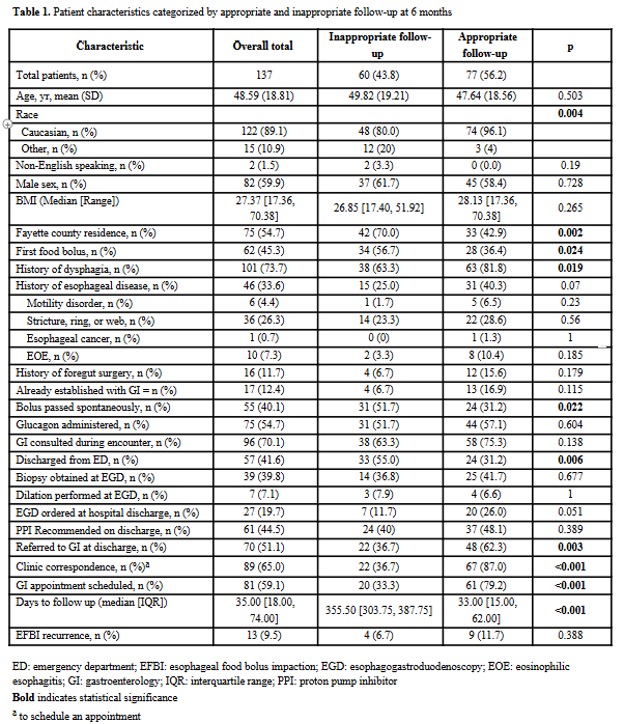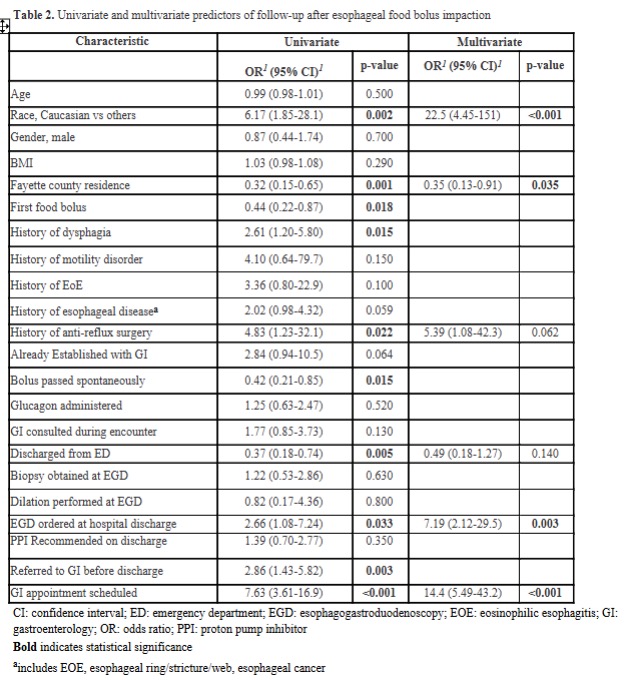Monday Poster Session
Category: Esophagus
P2785 - Assessing Variability in Predictors of Adequate Follow-Up After Esophageal Food Bolus Impaction: A Retrospective Study and Literature Review
Monday, October 27, 2025
10:30 AM - 4:00 PM PDT
Location: Exhibit Hall

Hannah Darnell, DO
University of Kentucky
Lexington, KY
Presenting Author(s)
Hannah Darnell, DO1, Sara Bidarian, MD2, Ren Bryant, DO3, Joel Richter, MD1, Bahaaeldeen Ismail, MD2
1University of Kentucky, Lexington, KY; 2University of Kentucky College of Medicine, Lexington, KY; 3College of Medicine, University of Kentucky, Lexington, KY
Introduction: Despite guidelines recommending comprehensive post-esophageal food bolus impaction (EFBI) evaluation, follow-up adherence varies. It remains unclear whether predictors of follow-up are consistent across studies or unique to individual populations. We assess post EFBI follow-up rates and predictors at our center and compare them to existing literature.
Methods: We retrospectively studied adults (≥18 years) presenting with EFBI between June 2021 and October 2024. Patients without follow-up data or with non-food bolus impactions were excluded. Patients were categorized by follow-up adequacy (endoscopy or office visit within six months). We compared demographic, clinical, and endoscopic variables. Predictors of follow up were identified using univariate and multivariate logistic regression. We also reviewed similar studies to identify differences in populations, study designs, and factors influencing follow-up variability across studies.
Results: Among 137 patients, 60 (43.8%) lacked adequate follow-up (table 1). Most of our patients were Caucasian (89.1%) and male (59.9%), with a mean age of 48.6 ± 18.8 years. Sixty-two patients (45.3%) presented with their first food impaction. Of those with previous food impactions, only 18.7% (14/75) were established with a GI provider. A documented history of dysphagia was present in 73.7% (101/137), while 33.6% (46/137) had pre-existing esophageal disease. On multivariate analysis, predictors of follow-up included Caucasian race (OR 22.53, P< 0.001), county of residence (OR 0.35, P=0.035), follow-up endoscopy orders (OR 7.19, P=0.003), and scheduled GI appointments (OR 14.4, P< 0.001) (table 2). A review of seven comparable studies involving 1,663 patients revealed variability in follow-up rates (16% to 55%), predictors of follow-up, and inconsistencies in inclusion criteria and follow-up definitions.
Discussion: Ambulatory follow-up after EFBI remains suboptimal, with 44% of our cohort lacking adequate follow-up within six months. We identified both modifiable and demographic predictors, including race, county of residence, and discharge planning practices. Our inclusive design and literature review revealed variability in follow-up rates and predictors across studies, highlighting the need for institution-specific strategies that address healthcare inequities and unexpected barriers. We offer recommendations to guide future research and quality improvement efforts.

Figure: Patient characteristics categorized by appropriate and inappropriate follow-up at 6 months

Figure: Univariate and multivariate predictors of follow-up after esophageal food bolus impaction
Disclosures:
Hannah Darnell indicated no relevant financial relationships.
Sara Bidarian indicated no relevant financial relationships.
Ren Bryant indicated no relevant financial relationships.
Joel Richter indicated no relevant financial relationships.
Bahaaeldeen Ismail indicated no relevant financial relationships.
Hannah Darnell, DO1, Sara Bidarian, MD2, Ren Bryant, DO3, Joel Richter, MD1, Bahaaeldeen Ismail, MD2. P2785 - Assessing Variability in Predictors of Adequate Follow-Up After Esophageal Food Bolus Impaction: A Retrospective Study and Literature Review, ACG 2025 Annual Scientific Meeting Abstracts. Phoenix, AZ: American College of Gastroenterology.
1University of Kentucky, Lexington, KY; 2University of Kentucky College of Medicine, Lexington, KY; 3College of Medicine, University of Kentucky, Lexington, KY
Introduction: Despite guidelines recommending comprehensive post-esophageal food bolus impaction (EFBI) evaluation, follow-up adherence varies. It remains unclear whether predictors of follow-up are consistent across studies or unique to individual populations. We assess post EFBI follow-up rates and predictors at our center and compare them to existing literature.
Methods: We retrospectively studied adults (≥18 years) presenting with EFBI between June 2021 and October 2024. Patients without follow-up data or with non-food bolus impactions were excluded. Patients were categorized by follow-up adequacy (endoscopy or office visit within six months). We compared demographic, clinical, and endoscopic variables. Predictors of follow up were identified using univariate and multivariate logistic regression. We also reviewed similar studies to identify differences in populations, study designs, and factors influencing follow-up variability across studies.
Results: Among 137 patients, 60 (43.8%) lacked adequate follow-up (table 1). Most of our patients were Caucasian (89.1%) and male (59.9%), with a mean age of 48.6 ± 18.8 years. Sixty-two patients (45.3%) presented with their first food impaction. Of those with previous food impactions, only 18.7% (14/75) were established with a GI provider. A documented history of dysphagia was present in 73.7% (101/137), while 33.6% (46/137) had pre-existing esophageal disease. On multivariate analysis, predictors of follow-up included Caucasian race (OR 22.53, P< 0.001), county of residence (OR 0.35, P=0.035), follow-up endoscopy orders (OR 7.19, P=0.003), and scheduled GI appointments (OR 14.4, P< 0.001) (table 2). A review of seven comparable studies involving 1,663 patients revealed variability in follow-up rates (16% to 55%), predictors of follow-up, and inconsistencies in inclusion criteria and follow-up definitions.
Discussion: Ambulatory follow-up after EFBI remains suboptimal, with 44% of our cohort lacking adequate follow-up within six months. We identified both modifiable and demographic predictors, including race, county of residence, and discharge planning practices. Our inclusive design and literature review revealed variability in follow-up rates and predictors across studies, highlighting the need for institution-specific strategies that address healthcare inequities and unexpected barriers. We offer recommendations to guide future research and quality improvement efforts.

Figure: Patient characteristics categorized by appropriate and inappropriate follow-up at 6 months

Figure: Univariate and multivariate predictors of follow-up after esophageal food bolus impaction
Disclosures:
Hannah Darnell indicated no relevant financial relationships.
Sara Bidarian indicated no relevant financial relationships.
Ren Bryant indicated no relevant financial relationships.
Joel Richter indicated no relevant financial relationships.
Bahaaeldeen Ismail indicated no relevant financial relationships.
Hannah Darnell, DO1, Sara Bidarian, MD2, Ren Bryant, DO3, Joel Richter, MD1, Bahaaeldeen Ismail, MD2. P2785 - Assessing Variability in Predictors of Adequate Follow-Up After Esophageal Food Bolus Impaction: A Retrospective Study and Literature Review, ACG 2025 Annual Scientific Meeting Abstracts. Phoenix, AZ: American College of Gastroenterology.

